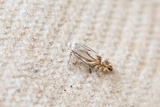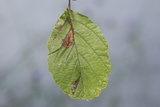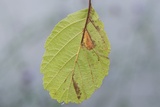Phyllonorycter rajella (Linnaeus, 1758) Species
Last modified: Dec. 10, 2025, 5:52 p.m.
A locally common species in Belgium, most often recorded in Flanders, more rarely in Wallonia.
Details
- Classification
- Family: Gracillariidae > Subfamily: Lithocolletinae > Genus: Phyllonorycter > Species: Phyllonorycter rajella
- Vernacular names
- Gewone elzenvouwmot (NL), Common alder midget (EN)
- Synonyms
- Phyllonorycter alnifoliella (Hübner, 1796) and Phyllonorycter alniella (Zeller, 1846)
- First mention in Belgium
- De Fré Ch. 1858. Catalogue des Microlépidoptères de la Belgique. — Annales de la Société entomologique belge 2: 45–162. On page 155 (as L.[ithocolletis] alnifoliella H.). view page
- Status
-
Native
Distribution
Imago
Head light brown, mixed with many white hairs; forewing ground colour golden brown with a white pattern consisting of a very broad basal line, edged with brown scales only on the upper side; sometimes a patch of white scales at the dorsum close to the base of the wing; four costal and three dorsal striae, finely edged with brown scales at the basal side; a spot of black scales in the apical area.
Mine
At first a round, but later long, tentiform mine on the underside of a leaf, most of the time in an axil of a secondary leaf, always situated between two secondary veins; underside with one central longitudinal fold. The underside of the mine is greenish at first, but later on it colours brownish.
See also gracillariidae.net and bladmineerders.be.
Cocoon/pupa
A tough greyish white cocoon, attached to both the roof and the floor of the mine. Frass is applied to the sides of the mine.
Bionomics
Especially in the autumn generation, many mines on one leaf. The species hibernates in the pupal stage, between leaf litter on the ground. After the emergence of the adult, the pupal skin protrudes from the mine.
Flight periods
Two generations a year in April–May and August–September.
Observed on
- Host plant (species):
- Alnus glutinosa, Alnus cordata and Alnus incana
- Host plant (genera):
- Alnus
The species is monophagous on: Alnus, especially Alnus glutinosa but also on A. cordata and A. incana.



